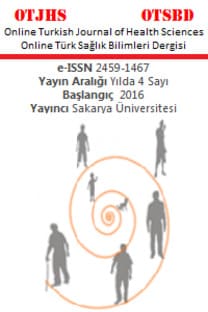Diyabetik Ayakta Anatomik Değişiklikler
Amputasyon, ayak lezyonları, nöropati, yara debridmanı
Anatomical Changes in Diabetic Foot
Amputation, foot lesions, neuropathy, wound debridement,
___
- 1. Reiber GE, Lipsky BA, Gibbons GW. The burden of diabetic foot ulcers. Am J Surg. 1998;176(2A Suppl):5S-10S.
- 2. Sanders LJ. Diabetes mellitus:Prevention of amputation. J Am Podiatr Med Assoc.1994; 84( 7): 322-328.
- 3. Quebedeaux TL, Lavery LA, Lavery DC. The development of foot deformities and ulcers after great toe amputation in diabetes. Diabetes Care. 1996 ;19(2):165-167.
- 4. Singh G, Chawla S. Amputation in Diabetic Patients. Med J Armed Forces India. 2011;62(1):36–39.
- 5. Edwards et al.: Health service pathways for patients with chronic leg ulcers: identifying effective pathways for facilitation of evidence based wound care. BMC Health Services Research 2013 13:86.doi:10.1186/1472-6963-13-86
- 6. Trautner C, Haastert B, Giani G, Berger M. Incidence of lower limb amputations and diabetes. Diabetes Care. 1996; 19(9):1006-9.
- 7. Naves CC. The Diabetic Foot: A Historical Overview and Gaps in Current Treatment. AdvWound Care (New Rochelle). 2016;5(5):191–197. doi:10.1089/wound.2013.0518
- 8. Apelqvist J, Ragnarson-Tennvall G, Persson U, Larsson J. Diabetic foot ulcers in a multidisciplinary setting. An economic analysis of primary healing and healing with amputation. J Intern Med. 1994 ;235(5):463-71.
- 9. Giugliano D, Ceriello A, Paolisso G. Oxidative stress and diabetic vascular complications. Diabetes Care. 1996 ;19(3):257-67.
- 10. Olokoba AB, Obateru OA, Olokoba LB. Type 2 diabetes mellitus: A review of current trends. Oman Med J. 2012;27(4):269–273.doi: 10.5001/omj.2012.68.
- 11. Karamanou M, Protogerou A, Tsoucalas G, Androutsos G, Poulakou-Rebelakou E. Milestones in the history of diabetes mellitus: The main contributors. World J Diabetes. 2016;7(1):1–7. doi:10.4239/wjd.v7.i1.1
- 12. Vecchio I, Tornali C, Bragazzi NL and Martini M. The Discovery of Insulin: An Important Milestone in the History of Medicine. Front. Endocrinol. 2018; 9:613. doi: 10.3389/fendo.2018.00613
- 13. Amin N, Doupis J. Diabetic foot disease: From the evaluation of the "foot at risk" to the novel diabetic ulcer treatment modalities. World J Diabetes. 2016;7(7):153–164. doi:10.4239/wjd.v7.i7.153
- 14. Nabuurs-Franssen MH, Houben AJ,Tooke JE et al..The effect of polyneuropathy on foot microcirculation in Type II diabetes. Diabetologia. 2002;45:1164–1171.doi: 10.1007/s00125-002-0872-z
- 15. Mayfield JA, Sugarman JR. The use of the Semmes-Weinstein monofilament and other threshold tests for preventing foot ulceration and amputation in persons with diabetes. J FamPract. 2000;49(11 Suppl):S17-29.
- 16. Smieja M, Hunt DL, Edelman D, Etchells E, Cornuz J, Simel DL. Clinical examination for the detection of protective sensation in the feet of diabetic patients. International Cooperative Group for Clinical Examination Research. J Gen Intern Med. 1999 ;14(7):418-24.
- 17. Boyko EJ, Ahroni JH, Stensel V et al. A prospective study of risk factors for diabetic foot ulcer. The Seattle Diabetic Foot Study. Diabetes Care. Jul 1999 ;22(7):1036-42.
- 18. Gooch C, Podwall D. The diabetic neuropathies. Neurologist. 2004;10(6):311-22.
- 19. Boulton AJ, Kubrusly DB, Bowker JH et al. Impaired vibratory perception and diabetic foot ulceration.Diabet Med. 1986;3(4):335-7.
- 20. Armstrong DG, Lavery LA. Diabetic foot ulcers: prevention, diagnosis andclassification. Am Fam Physician. 1998 ; 57(6):1325-32.
- 21. Brand PW. Management of the insensitive limb. Phys Ther. 1979 ;59(1):8-12.
- 22. Guy RJ, Clark CA, Malcolm PN, Watkins PJ. Evaluation of thermal and vibration sensation in diabetic neuropathy. Diabetologia. 1985 ;28(3):131-7.
- 23. Andersen H. Motor dysfunction in diabetes. Diabetes Metab Res Rev. 2012 ;28Suppl 1:89-92.
- 24. Shaw JE, Boulton AJ. The pathogenesis of diabetic foot problems: an overview. Diabetes. 1997 ;46Suppl 2:S58-61.
- 25. Chung T, Prasad K, Lloyd TE. Peripheral neuropathy: clinical and electrophysiological considerations. Neuroimaging Clin N Am. 2014;24(1):49–65. doi:10.1016/j.nic.2013.03.023
- 26. Pryce TD. A case of perforating ulcers of both feet associated with diabetes and ataxic symptoms. Lancet . 1887 : 11-12.
- 27. Martin MM. Neuropathic lesions of the feet in diabetes mellitus. Proc R Soc Med. 1954 ;47(2):139-40.
- 28. Ellenberg M. Diabeicneuropathic ulcer. J Mt Sinai Hosp. 1968; 35: 585-594.
- ISSN: 2459-1467
- Yayın Aralığı: Yılda 4 Sayı
- Başlangıç: 2016
- Yayıncı: Oğuz KARABAY
Laboratuvar Verimlilik Komisyonu Değerlendirilmesi
Hilal USLU YUVACI, Mehmet Musa ASLAN, Elif KÖSE, Merve KESKİN PAKER, Arif Serhan CEVRİOĞLU
Adolesan Çocuklarda Nutrisyonel Anemi Nedenleri
Epstein-Barr Virus İnfeksiyonuna Sekonder Olarak Gelişen Otoimmun Hemolitik Anemi: Bir Vaka Raporu
Nevin Ince, F. Elif ÇELİK, Birgül ÖNEÇ, Hilal şöhret UYANIK
Spontan İntranazal Meningosel: Bir Olgu Sunumu
Radyasyon Çalışanlarının Radyasyon Bilinci Anketi
Ahmet murat ŞENIŞIK, Duygu TUNÇMAN GENÇ, Eda MUTLU
RAZİYE DESDİCİOĞLU, MELAHAT YILDIRIM, Ayşe filiz YAVUZ, Sefer GEDİKTAŞ, Ceylan BAL, Özcan EREL
Pınar YILDIZ, Fatih ÜZER, Ege GÜLEÇ BALBAY
Hilal USLU YUVACI, Mehmet Musa ASLAN, Elif KÖSE, Merve KESKİN PAKER, Arif Serhan CEVRİOĞLU
